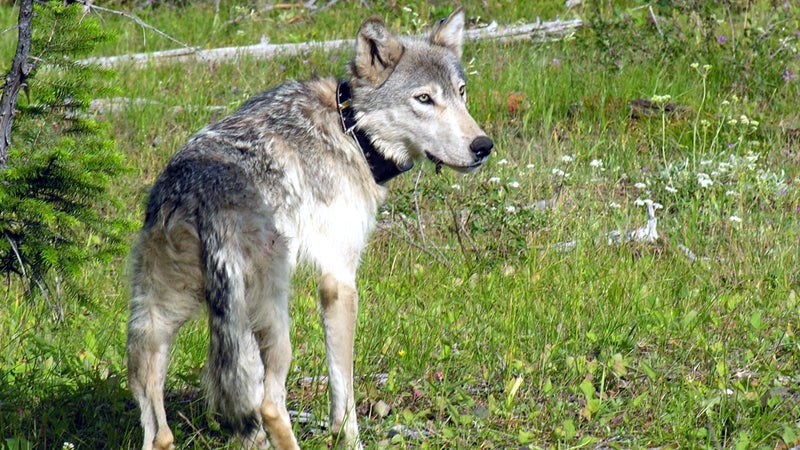When compelled, wolves travel far. In the search for prey, they might cover up to 50 miles in a single day. When a single wolf disperses from its pack, however, it can move hundreds of miles over a handful of days or longer. That's what a male gray wolf dubbed OR-7 did in late 2011. When he set out from his pack in northeastern Oregon, he tripped off a drama that made him Twitter-famous, amplified the debate over protecting wolves—and, recently, has a devoted public following giddy with anticipation over a possible new wolf family.
OR-7 was so-named because he was the seventh wolf in Oregon to be fitted with a radio collar, and it is from that collar that his story is being told.
His mother, a collared wolf from Idaho, had swum the Snake River to enter Oregon in early 2008 and it is believed OR-7's father had done the same. This pair mated and began the Imnaha pack in 2009, starting with OR-7 and his littermates.
In February 2011, OR-7 was captured and collared, with three others from his pack. In late 2011, he left the pack, most likely to find a mate. Had he traveled north into Washington or east into Idaho, he may have found one. But OR-7 headed southwest, where no wolves were known to exist. One day in late December, unbeknownst to him, he made history by crossing over the southern Oregon border and trotting into California. He is the first and only known wolf to enter into the Golden State since wolves were extirpated here in the 1920s.
Wolf conservationists were excited, but also nervous. While the gray wolf is currently listed on the federal Endangered Species Act (ESA), last summer the US Fish and Wildlife Agency made its long-awaited move to delist them (this is proposal has since been and is still pending).
As OR-7 lingered inside California during most of 2012, he began attracting attention. OR-7's collar is equipped with a GPS transceiver, so his location is updated continuously and automatically to the Oregon Department of Fish and Wildlife's website. The California Department of Fish and Wildlife (DFW) even started a —though it did not offer up precise locations (perhaps to avoid helping nefarious parties who take unkindly to wolves entering the state).
Over the past year, it appeared OR-7's fame would fade as he slipped back into Oregon. In early May, however, wolf biologists with the Oregon DFW made an . Trail cameras that they installed in the Rogue River-Siskiyou National Forest, where OR-7 has been spending a fair amount of time lately, captured images of a second wolf. Based on its shape and behavior (like squatting to urinate), biologists are confident this wolf is female.
The second wolf is big news, but what has biologists really intrigued is that, while they have not been captured in the camera at the same time, both of the wolves have recently passed it, and OR-7's collar data shows his activity is consistent with building a den. There is a good chance OR-7 has mated with the other wolf. Wolf pups are generally born in mid-April, but biologists are keeping a good distance from the presumed den site, to ensure the wolves don't pick up and try to move their offspring.
Cue the Cameras
Meanwhile, a film crew has recently set off on , a 1,200-mile, 6-week journey to retrace OR-7's path from his home in the northeastern reaches of Oregon, into California. Their goal is to create a documentary, funded through , and to use OR-7's story as a means of exploring the human-wolf dynamics, past and present.
In addition to the film they plan to generate educational materials and create an e-book with stories, video, and audio recordings of interviews with wolf and wildlife experts, as well as ranches, conservationists, big-game hunters.
“Our mission is to understand what is needed for co-existence with wolves,” says Galeo Saintz, a wilderness guide and conservation ecologist. “The bottom line is: how do we, as different communities, find common ground?”
Saintz and his expedition mates, who include an outdoor educator, wildlife tracker, multimedia producer, and a filmmaker—Daniel Byers from —will spend two thirds of the trip on mountain bikes, on trails that approximately parallel OR-7's path. That is partly in the interest of making good time. “When OR-7 moved across the sagebrush country near Sisters, he went quite fast,” says Saintz. A wolf can run 25 miles per hour (faster when chasing prey), though OR-7 would not have maintained that speed. The remaining third of the trip they'll complete on foot.
Possible Progeny
The possibility that OR-7 and the newly discovered wolf have mated has added new urgency to questions around how California will address the management of wolves. If they do produce healthy offspring, the chances are good that these new wolves will ramble over the border—either for short visits, or maybe to stay.
Amaroq Weiss, west coast wolf organizer for the , believes this mystery wolf might have been traveling into and out of California along with OR-7 earlier this year. “He was in the state during parts of January and February, which is mating season,” she notes.
Weiss leads the petition to California's Fish and Game Commission to list the gray wolf under the California Endangered Species Act (CESA). Even if the U.S. Fish and Wildlife agency was not close to delisting the wolf from the federal ESA, she says, adding the animal to the CESA is a prudent management decision. That's because eventually the gray wolf is likely to be delisted federally. If California does not have its own protections for the species set up at that point, Weiss feels it could be extirpated all over again. (Without ESA protection, wolves in California would be treated and “non-game mammals” which landowners can shoot if the animal is taking livestock or otherwise harming property.)
The Commission is currently mulling whether to list wolves under CESA. Soon after the petition was first filed, the state's Department of Fish and Wildlife determined that the listing proposal “warranted further investigation,” says Eric Loft, chief of the agency's wildlife and fisheries division.
A year later, however, after compiling a on the matter, the Department suggested to the Commission that the wolf not be listed under CESA. Despite its length, the report came to a rather simple conclusion: That because there is no compelling science to describe how the wolves would fare in the state, there is no science to back up the proposal that they be protected.
To Weiss, that is an unsound argument. In testimony at an April hearing, she pointed to other species that have been placed under CESA in the past, despite not existing in the state in any meaningful numbers. “We think they are trying to appease stakeholders who don’t want to see it listed,” she says of the Department's recommendation. “It's basically a political maneuver.”
Loft counters that the decisions around previous species listings that Weiss points to as precedent were made using “professional judgment” and that the Department has since instituted a policy to focus recommendations on scientific findings.
As for allegations of political pressure, he says: “Yes, we are being pressured by stakeholders that don't want to see wolves here. But that does not make us sway our recommendation. We made that based on the best science available.”
The Fish and Game Commission will hold a public meeting to get more input on the listing proposal on June 4th in Fortuna, Calif., and is expected to make its decision in July.
Watching and Waiting in Oregon
Back up in Oregon's Rogue River-Siskiyou National Forest, John Stephenson, wolf biologist with the U.S. Fish and Wildlife, has been watching and waiting to see if OR-7 has sired a new generation of wolves.
As he was wrapping up some field work this week, he said a quick scan of the trail camera seemed to indicate some fresh wolf photos. No word yet on pups.
Where could this female wolf come from? Stephenson hopes an analysis of wolf scat picked up near the camera might give some clues. Like OR-7, it most likely traveled quite a distance. Over the past year there have been occasional reports of what people believe to be a black wolf, which matches the female's color, in central Oregon's Cascade Mountains.
As for how the two animals found each other in such a vast area, he says they might have been able to pick up each other's scent from a remarkable distance.
While we wait to learn of OR-7's next steps, you can follow along on the Wolf OR-7 Expedition journey on .
In the nearer term, the documentary filmmaker Clemens Schenk has made his own film, called “.” It premieres this coming Sunday in Portland, Oregon.
I asked Stephenson if he'll attend. “I don't know, I live in Bend and it's quite a ways from Portland. I saw the trailer, though, and I would like to know who they have playing OR-7. He's not collared, so it's not him.”
Editor’s Note: Wildlife officials confirmed in early June that OR-7 has sired at least two pups. And June 4, California’s Fish and Game Commission voted 3-1 in favor of the listing the gray wolf on the state’s endangered species list.


